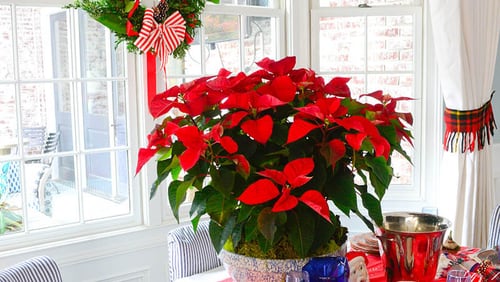Brightly colored poinsettias have become staples during the holiday season. The poinsettia, which naturally bloom in November and December in their native Mexico, is the second most popular flowering potted plant in the country, second only to orchids. That's quite a statistic as dramatic for the showy plant especially considering poinsettias are sold only a few weeks out of the year.
Poinsettias were first sent to the United States in 1828 by Joel Poinsett, the first minister to Mexico and a native South Carolinian. Jim Faust, an associate professor of horticulture at Clemson University, carries on local ties to the plant. He co-wrote the quintessential guide to growing the plant, "Ecke Poinsettia Manual," and he created the "Ecke Bract Meter" to help growers time the plants' blooms and colorful leaves.
Once the plant is taken home, it must be properly cared for to continue to look showy throughout the holiday season. Here are some tips from Faust to help these festive plants last:
• Place poinsettias in bright locations where the plants can receive as much light as possible.
• Keep poinsettias away from drafts, heating and air conditioning vents, as well as heaters.
• Avoid letting the bracts touch cold windowpanes because the transfer of outdoor temperatures can cause damage.
• Keep poinsettia plants moist but not soggy. Overwatering is a major cause of early leaf and bract drop in poinsettias.
• Maintain temperatures from 60 to 75 degrees.
• Do not fertilize the plants when they are flowering.
Proper care after the holiday season can help ensure poinsettia plants can bring cheer in the future. To help your poinsettia last:
• Prune the plant back to about eight inches tall around March or April.
• Keep the plant near a sunny window and continue to water it regularly.
• Move the plant outdoors once the nighttime temperature remains above 50 degrees.
• Fertilize the plant every two to three weeks during the spring, summer and fall with a well-balanced complete fertilizer, such as 10-10-10.
• Transplant the poinsettia in early June into a container two to four inches bigger than the original pot. Use a soil mix containing a considerable amount of organic matter, such as compost, leaf mold or peat moss. Pinch back the shoot tips or prune back the branches. Do not pinch back after August.
• Bringing the plant indoors, to a sunny location, when nighttime temperatures become cool.
• Don’t expect these plants to flower like those grown inside of greenhouses. Most houses do not have sufficient light for the plant to grow big, beautiful flowers.
About the Author







